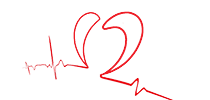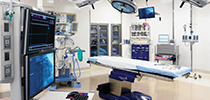Heart Rhythm Institute
Posted on July 1st, 2023
The heart is made up of four chambers: the left and right atria and the left and right ventricle. The atria are the upper chambers where blood enters the heart.
Blood that has been depleted of oxygen by the body enters the right atrium. This atrium controls the flow of blood to the right ventricle, which sends blood out to the lungs for oxygenation. On the left side of the heart, the atrium... Read More
Posted on June 1st, 2023
Every heartbeat is controlled by the heart’s electrical system. The sinus node in the heart’s electrical system sends a signal that causes the muscle to contract starting with the atria and moving to the ventricles. Sometimes, the electrical system creates an irregular pattern called an arrhythmia. Arrhythmias can include heartbeats that are too fast (tachycardia), too slow (bradycardia), or... Read More
Posted on May 1st, 2023
Standing up every morning is perhaps one of the most basic actions we take. Most people stand up without a second thought, but for some, it can bring a host of symptoms from dizziness to brain fog to a general feeling of illness. Eventually, they may be diagnosed with a condition called postural orthostatic tachycardia syndrome, or POTS.
What is postural orthostatic tachycardia syndrome?... Read More
Posted on April 1st, 2023
The heart is made up of four chambers: two ventricles and two atria. The ventricles are the two lower chambers, which are responsible for pumping blood out of the heart.
The right ventricle pumps blood to the lungs, so it can be oxygenated. After the lungs add oxygen, blood travels back to the heart and enters the left side of the heart. The upper chamber, or atria, receives the blood and... Read More
Posted on March 1st, 2023
The recent sudden cardiac arrest of a young professional football player has brought attention to a heart condition called commotio cordis. Although commotio cordis has not been definitively identified in this case, many cardiologists and experts suspect it may have been the cause of the athlete’s cardiac arrest on the field.
Commotio cordis is a heart condition in which an object striking... Read More
Posted on February 1st, 2023
A blood clot is a collection of cells, protein, and platelets that have stuck to each other to form a semi-solid mass. Clotting is an important part of the body’s ability to heal. When there is an injury that causes bleeding, the body’s natural response is to stop the bleeding through clotting.
However, sometimes clots form inside veins due to an abnormal heart rhythm, inefficient blood flow, an... Read More
Posted on January 1st, 2023
An arrhythmia, also known as an abnormal heart rhythm, is when the heart beats too fast, too slow, or irregularly. Arrhythmia carries a wide range of symptoms and severity, from arrythmias with no symptoms or sporadic symptoms to those with persistent symptoms that can be life-threatening.
Many of the symptoms overlap with other common heart conditions. Common symptoms include racing... Read More
Posted on December 1st, 2022
Sick sinus syndrome is a type of heart rhythm disorder that originates in the sinus node, which is the heart’s natural pacemaker. The electrical system sends a pulse that stimulates different parts of the heart to contract in the correct order and rhythm. The sinus node adapts to the body’s movement and other stimuli that cause the heart to beat faster or slower to regulate how the heart beats.... Read More
Posted on November 1st, 2022
Atrial fibrillation (AFib) is the most common heart rhythm disorder. Often noted by patients as a fluttering sensation in the chest, AFib can be occasional or chronic. Millions of Americans live with AFib, and many are unaware of their condition.
Symptoms of AFib range from fluttering or skipped heart beats to fatigue and weakness. Many patients have no symptoms at all and their condition... Read More
Posted on October 1st, 2022
Healthy heartbeats follow a typical pattern. When that pattern is disrupted by damage to the heart or a problem with the heart’s electrical system, it creates an irregular heartbeat, known as an arrhythmia. Arrhythmias often cause the heart to beat too fast or too slow, but other times they create a heartbeat that is out of sync or erratic.
Arrhythmias range in severity, with some requiring... Read More














